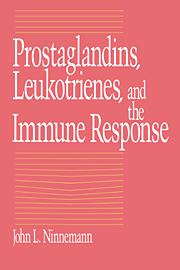Book contents
- Frontmatter
- Contents
- Foreword by James S. Goodwin
- Preface
- 1 A brief history and introduction
- 2 Prostaglandin/leukotriene structure and chemistry: a primer
- 3 Monocytes and macrophages
- 4 Lymphocyte response
- 5 Inflammation and the neutrophil
- 6 Malignancy and the arachidonic acid cascade
- 7 Tissue and organ transplantation
- 8 Rheumatoid arthritis and autoimmunity
- 9 Traumatic injury and surgery
- 10 Allergy
- Index
5 - Inflammation and the neutrophil
Published online by Cambridge University Press: 24 November 2009
- Frontmatter
- Contents
- Foreword by James S. Goodwin
- Preface
- 1 A brief history and introduction
- 2 Prostaglandin/leukotriene structure and chemistry: a primer
- 3 Monocytes and macrophages
- 4 Lymphocyte response
- 5 Inflammation and the neutrophil
- 6 Malignancy and the arachidonic acid cascade
- 7 Tissue and organ transplantation
- 8 Rheumatoid arthritis and autoimmunity
- 9 Traumatic injury and surgery
- 10 Allergy
- Index
Summary
Inflammation is a response by which the body repairs tissue damage and defends itself against infection. It is not an immunological response in the traditional sense, since it is nonspecific and can be initiated by completely nonimmune pathways (1–3). Immunological cells and effector mechanisms, however, are commonly participants in the process. The purpose of inflammation is to deliver plasma and cellular components of the blood to extravascular tissues, causing dilution of toxic materials, increase in lymph flow, phagocytosis of damaged tissue and contaminating materials or organisms, and (in the late stages of inflammation) formation of a fibrotic barrier which walls off infection.
Inflammatory responses can result from a variety of immunological processes including a T-lymphocyte-mediated mechanism in allergic contact dermatitis, and a humoral-antibody-mediated process in pemphigus. The cells involved in acute inflammation include mast cells, neutrophils, platelets, and eosinophils, which appear to act in a predictable sequence. The inflammatory sequence is initiated by chemical mediators released from the mast cells, which are found adjacent to small arterioles and in submucosal tissues. These mediators, summarized in Figure 5.1, dilate vessels and initiate a cascade of important events, including participation of the neutrophil in the inflammatory response.
Histamine is the major preformed mast cell mediator, synthesized from the amino acid L-histidine by the action of the enzyme L-histidine decarboxylase. The biological effects of histamine are mediated through two distinct receptor systems, H1 and H2.
- Type
- Chapter
- Information
- Prostaglandins, Leukotrienes, and the Immune Response , pp. 97 - 112Publisher: Cambridge University PressPrint publication year: 1988
- 1
- Cited by



